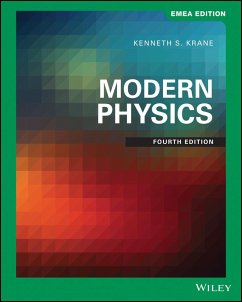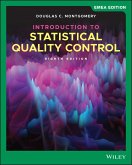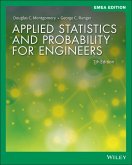Kenneth S. Krane (Oregon State University)
Modern Physics, EMEA Edition
Kenneth S. Krane (Oregon State University)
Modern Physics, EMEA Edition
- Broschiertes Buch
- Merkliste
- Auf die Merkliste
- Bewerten Bewerten
- Teilen
- Produkt teilen
- Produkterinnerung
- Produkterinnerung
One of the field's most respected introductory texts, Modern Physics provides a deep exploration of fundamental theory and experimentation. Appropriate for second-year undergraduate science and engineering students, this esteemed text presents a comprehensive introduction to the concepts and methods that form the basis of modern physics, including examinations of relativity, quantum physics, statistical physics, nuclear physics, high energy physics, astrophysics, and cosmology. A balanced pedagogical approach examines major concepts first from a historical perspective, then through a modern…mehr
Andere Kunden interessierten sich auch für
![Introduction to Statistical Quality Control, EMEA Edition Introduction to Statistical Quality Control, EMEA Edition]() Douglas C. Montgomery (Georgia Institute of Technology)Introduction to Statistical Quality Control, EMEA Edition68,99 €
Douglas C. Montgomery (Georgia Institute of Technology)Introduction to Statistical Quality Control, EMEA Edition68,99 €![Principles of Human Anatomy, EMEA Edition Principles of Human Anatomy, EMEA Edition]() Gerard J. Tortora (Bergen Community College)Principles of Human Anatomy, EMEA Edition78,99 €
Gerard J. Tortora (Bergen Community College)Principles of Human Anatomy, EMEA Edition78,99 €![Fundamentals of Machine Component Design, EMEA Edition Fundamentals of Machine Component Design, EMEA Edition]() Robert C. Juvinall (University of Michigan)Fundamentals of Machine Component Design, EMEA Edition68,99 €
Robert C. Juvinall (University of Michigan)Fundamentals of Machine Component Design, EMEA Edition68,99 €![Fox and McDonald's Introduction to Fluid Mechanics, EMEA Edition Fox and McDonald's Introduction to Fluid Mechanics, EMEA Edition]() Robert W. Fox (Purdue University)Fox and McDonald's Introduction to Fluid Mechanics, EMEA Edition68,99 €
Robert W. Fox (Purdue University)Fox and McDonald's Introduction to Fluid Mechanics, EMEA Edition68,99 €![Applied Statistics and Probability for Engineers, EMEA Edition Applied Statistics and Probability for Engineers, EMEA Edition]() Douglas C. Montgomery (Georgia Institute of Technology)Applied Statistics and Probability for Engineers, EMEA Edition68,99 €
Douglas C. Montgomery (Georgia Institute of Technology)Applied Statistics and Probability for Engineers, EMEA Edition68,99 €![Process Dynamics and Control, EMEA Edition Process Dynamics and Control, EMEA Edition]() Dale E. Seborg (Santa Barbara University of California)Process Dynamics and Control, EMEA Edition71,99 €
Dale E. Seborg (Santa Barbara University of California)Process Dynamics and Control, EMEA Edition71,99 €![Karp's Cell and Molecular Biology, EMEA Edition Karp's Cell and Molecular Biology, EMEA Edition]() Gerald Karp (Gainesville Formerly of the University of Florida)Karp's Cell and Molecular Biology, EMEA Edition71,99 €
Gerald Karp (Gainesville Formerly of the University of Florida)Karp's Cell and Molecular Biology, EMEA Edition71,99 €-
-
-
One of the field's most respected introductory texts, Modern Physics provides a deep exploration of fundamental theory and experimentation. Appropriate for second-year undergraduate science and engineering students, this esteemed text presents a comprehensive introduction to the concepts and methods that form the basis of modern physics, including examinations of relativity, quantum physics, statistical physics, nuclear physics, high energy physics, astrophysics, and cosmology. A balanced pedagogical approach examines major concepts first from a historical perspective, then through a modern lens using relevant experimental evidence and discussion of recent developments in the field. The emphasis on the interrelationship of principles and methods provides continuity, creating an accessible "storyline" for students to follow. Extensive pedagogical tools aid in comprehension, encouraging students to think critically and strengthen their ability to apply conceptual knowledge to practical applications. Numerous exercises and worked examples reinforce fundamental principles.
Hinweis: Dieser Artikel kann nur an eine deutsche Lieferadresse ausgeliefert werden.
Hinweis: Dieser Artikel kann nur an eine deutsche Lieferadresse ausgeliefert werden.
Produktdetails
- Produktdetails
- Verlag: John Wiley & Sons Inc
- 4 ed
- Seitenzahl: 592
- Erscheinungstermin: 6. September 2019
- Englisch
- Abmessung: 253mm x 206mm x 32mm
- Gewicht: 1408g
- ISBN-13: 9781119590583
- ISBN-10: 1119590582
- Artikelnr.: 57674367
- Herstellerkennzeichnung
- Libri GmbH
- Europaallee 1
- 36244 Bad Hersfeld
- gpsr@libri.de
- Verlag: John Wiley & Sons Inc
- 4 ed
- Seitenzahl: 592
- Erscheinungstermin: 6. September 2019
- Englisch
- Abmessung: 253mm x 206mm x 32mm
- Gewicht: 1408g
- ISBN-13: 9781119590583
- ISBN-10: 1119590582
- Artikelnr.: 57674367
- Herstellerkennzeichnung
- Libri GmbH
- Europaallee 1
- 36244 Bad Hersfeld
- gpsr@libri.de
Preface v
1. Some Deficiencies of Classical Physics 1
1.1 Review of Classical Physics 3
1.2 Deficiencies in Classical Concepts of Space and Time 11
1.3 Deficiencies in the Classical Theory of Particle Statistics 13
1.4 Theory, Experiment, Law 21
Questions 22
Problems 23
2. The Special Theory of Relativity 25
2.1 Classical Relativity 26
2.2 The Michelson-Morley Experiment 29
2.3 Einstein's Postulates 31
2.4 Consequences of Einstein's Postulates 32
2.5 The Lorentz Transformation 41
2.6 The Twin Paradox 46
2.7 Relativistic Dynamics 48
2.8 Conservation Laws in Relativistic Decays and Collisions 54
2.9 Experimental Tests of Special Relativity 58
Questions 65
Problems 66
3. The Particle-Like Properties of Electromagnetic Radiation 71
3.1 Review of Electromagnetic Waves 72
3.2 The Photoelectric Effect 77
3.3 Thermal Radiation 83
3.4 The Compton Effect 90
3.5 Other Photon Processes 93
3.6 Particles or Waves 96
Questions 99
Problems 100
4. The Wavelike Properties of Particles 105
4.1 De Broglie's Hypothesis 106
4.2 Experimental Evidence for De Broglie Waves 108
4.3 Uncertainty Relationships for Classical Waves 115
4.4 Heisenberg Uncertainty Relationships 118
4.5 Wave Packets 124
4.6 The Motion of a Wave Packet 128
4.7 Probability and Randomness 131
Questions 133
Problems 134
5. The Schrödinger Equation 139
5.1 Behavior of a Wave at a Boundary 140
5.2 Confining a Particle 144
5.3 The Schrödinger Equation 146
5.4 Applications of the Schrödinger Equation 150
5.5 The Simple Harmonic Oscillator 162
5.6 Steps and Barriers 165
Questions 173
Problems 174
6. The Rutherford-Bohr Model of the Atom 177
6.1 Basic Properties of Atoms 178
6.2 Scattering Experiments and the Thomson Model 179
6.3 The Rutherford Nuclear Atom 182
6.4 Line Spectra 188
6.5 The Bohr Model 191
6.6 The Franck-Hertz Experiment 197
6.7 The Correspondence Principle 199
6.8 Deficiencies of the Bohr Model 201
Questions 203
Problems 203
7. The Hydrogen Atom in Wave Mechanics 207
7.1 A One-Dimensional Atom 208
7.2 Angular Momentum in the Hydrogen Atom 210
7.3 The Hydrogen Atom Wave Functions 213
7.4 Radial Probability Densities 218
7.5 Angular Probability Densities 220
7.6 Intrinsic Spin 222
7.7 Energy Levels and Spectroscopic Notation 227
7.8 The Zeeman Effect 228
7.9 Fine Structure 230
Questions 232
Problems 233
8. Many-Electron Atoms 237
8.1 The Pauli Exclusion Principle 238
8.2 Electronic States in Many-Electron Atoms 240
8.3 Outer Electrons: Screening and Optical Transitions 244
8.4 Properties of the Elements 248
8.5 Inner Electrons: Absorption Edges and X Rays 253
8.6 Addition of Angular Momenta 257
8.7 Lasers 261
Questions 265
Problems 266
9. Molecular Structure 269
9.1 The Hydrogen Molecule 270
9.2 Covalent Bonding in Molecules 274
9.3 Ionic Bonding 282
9.4 Molecular Vibrations 286
9.5 Molecular Rotations 290
9.6 Molecular Spectra 294
Questions 298
Problems 299
10. Statistical Physics 303
10.1 Statistical Analysis 304
10.2 Classical and Quantum Statistics 306
10.3 The Density of States 310
10.4 The Maxwell-Boltzmann Distribution 315
10.5 Quantum Statistics 321
10.6 Applications of Bose-Einstein Statistics 324
10.7 Applications of Fermi-Dirac Statistics 330
Questions 336
Problems 337
11. Solid-State Physics 341
11.1 Crystal Structures 342
11.2 The Heat Capacity of Solids 350
11.3 Electrons in Metals 354
11.4 Band Theory of Solids 358
11.5 Superconductivity 364
11.6 Intrinsic and Impurity Semiconductors 369
11.7 Semiconductor Devices 372
11.8 Magnetic Materials 376
Questions 383
Problems 384
12. Nuclear Structure and Radioactivity 389
12.1 Nuclear Constituents 390
12.2 Nuclear Sizes and Shapes 392
12.3 Nuclear Masses and Binding Energies 394
12.4 The Nuclear Force 399
12.5 Quantum States in Nuclei 401
12.6 Radioactive Decay 403
12.7 Alpha Decay 407
12.8 Beta Decay 410
12.9 Gamma Decay and Nuclear Excited States 414
12.10 Natural Radioactivity 418
Questions 421
Problems 423
13. Nuclear Reactions and Applications 427
13.1 Types of Nuclear Reactions 428
13.2 Radioisotope Production in Nuclear Reactions 432
13.3 Low-Energy Reaction Kinematics 434
13.4 Fission 437
13.5 Fusion 443
13.6 Nucleosynthesis 450
13.7 Applications of Nuclear Physics 453
Questions 459
Problems 459
14. Elementary Particles 463
14.1 The Four Basic Forces 464
14.2 Classifying Particles 466
14.3 Conservation Laws 471
14.4 Particle Interactions and Decays 475
14.5 Energy and Momentum in Particle Decays 481
14.6 Energy and Momentum in Particle Reactions 483
14.7 The Quark Structure of Mesons and Baryons 487
14.8 The Standard Model 494
Questions 499
Problems 499
15. Cosmology: The Origin and Fate of the Universe 503
15.1 The Expansion of the Universe 504
15.2 The Cosmic Microwave Background Radiation 508
15.3 Dark Matter 510
15.4 The General Theory of Relativity 512
15.5 Tests of General Relativity 519
15.6 Stellar Evolution and Black Holes 523
15.7 Cosmology and General Relativity 528
15.8 The Big Bang Cosmology 530
15.9 The Formation of Nuclei and Atoms 533
15.10 Experimental Cosmology 536
Questions 541
Problems 542
Appendix A: Constants and Conversion Factors 545
Appendix B: Complex Numbers 547
Appendix C: Periodic Table of the Elements 549
Appendix D: Table of Atomic Masses 551
Appendix E: Some Milestones in the History of Modern Physics 561
Answers to Odd-Numbered Problems 565
Index 569
Index to Tables 577
1. Some Deficiencies of Classical Physics 1
1.1 Review of Classical Physics 3
1.2 Deficiencies in Classical Concepts of Space and Time 11
1.3 Deficiencies in the Classical Theory of Particle Statistics 13
1.4 Theory, Experiment, Law 21
Questions 22
Problems 23
2. The Special Theory of Relativity 25
2.1 Classical Relativity 26
2.2 The Michelson-Morley Experiment 29
2.3 Einstein's Postulates 31
2.4 Consequences of Einstein's Postulates 32
2.5 The Lorentz Transformation 41
2.6 The Twin Paradox 46
2.7 Relativistic Dynamics 48
2.8 Conservation Laws in Relativistic Decays and Collisions 54
2.9 Experimental Tests of Special Relativity 58
Questions 65
Problems 66
3. The Particle-Like Properties of Electromagnetic Radiation 71
3.1 Review of Electromagnetic Waves 72
3.2 The Photoelectric Effect 77
3.3 Thermal Radiation 83
3.4 The Compton Effect 90
3.5 Other Photon Processes 93
3.6 Particles or Waves 96
Questions 99
Problems 100
4. The Wavelike Properties of Particles 105
4.1 De Broglie's Hypothesis 106
4.2 Experimental Evidence for De Broglie Waves 108
4.3 Uncertainty Relationships for Classical Waves 115
4.4 Heisenberg Uncertainty Relationships 118
4.5 Wave Packets 124
4.6 The Motion of a Wave Packet 128
4.7 Probability and Randomness 131
Questions 133
Problems 134
5. The Schrödinger Equation 139
5.1 Behavior of a Wave at a Boundary 140
5.2 Confining a Particle 144
5.3 The Schrödinger Equation 146
5.4 Applications of the Schrödinger Equation 150
5.5 The Simple Harmonic Oscillator 162
5.6 Steps and Barriers 165
Questions 173
Problems 174
6. The Rutherford-Bohr Model of the Atom 177
6.1 Basic Properties of Atoms 178
6.2 Scattering Experiments and the Thomson Model 179
6.3 The Rutherford Nuclear Atom 182
6.4 Line Spectra 188
6.5 The Bohr Model 191
6.6 The Franck-Hertz Experiment 197
6.7 The Correspondence Principle 199
6.8 Deficiencies of the Bohr Model 201
Questions 203
Problems 203
7. The Hydrogen Atom in Wave Mechanics 207
7.1 A One-Dimensional Atom 208
7.2 Angular Momentum in the Hydrogen Atom 210
7.3 The Hydrogen Atom Wave Functions 213
7.4 Radial Probability Densities 218
7.5 Angular Probability Densities 220
7.6 Intrinsic Spin 222
7.7 Energy Levels and Spectroscopic Notation 227
7.8 The Zeeman Effect 228
7.9 Fine Structure 230
Questions 232
Problems 233
8. Many-Electron Atoms 237
8.1 The Pauli Exclusion Principle 238
8.2 Electronic States in Many-Electron Atoms 240
8.3 Outer Electrons: Screening and Optical Transitions 244
8.4 Properties of the Elements 248
8.5 Inner Electrons: Absorption Edges and X Rays 253
8.6 Addition of Angular Momenta 257
8.7 Lasers 261
Questions 265
Problems 266
9. Molecular Structure 269
9.1 The Hydrogen Molecule 270
9.2 Covalent Bonding in Molecules 274
9.3 Ionic Bonding 282
9.4 Molecular Vibrations 286
9.5 Molecular Rotations 290
9.6 Molecular Spectra 294
Questions 298
Problems 299
10. Statistical Physics 303
10.1 Statistical Analysis 304
10.2 Classical and Quantum Statistics 306
10.3 The Density of States 310
10.4 The Maxwell-Boltzmann Distribution 315
10.5 Quantum Statistics 321
10.6 Applications of Bose-Einstein Statistics 324
10.7 Applications of Fermi-Dirac Statistics 330
Questions 336
Problems 337
11. Solid-State Physics 341
11.1 Crystal Structures 342
11.2 The Heat Capacity of Solids 350
11.3 Electrons in Metals 354
11.4 Band Theory of Solids 358
11.5 Superconductivity 364
11.6 Intrinsic and Impurity Semiconductors 369
11.7 Semiconductor Devices 372
11.8 Magnetic Materials 376
Questions 383
Problems 384
12. Nuclear Structure and Radioactivity 389
12.1 Nuclear Constituents 390
12.2 Nuclear Sizes and Shapes 392
12.3 Nuclear Masses and Binding Energies 394
12.4 The Nuclear Force 399
12.5 Quantum States in Nuclei 401
12.6 Radioactive Decay 403
12.7 Alpha Decay 407
12.8 Beta Decay 410
12.9 Gamma Decay and Nuclear Excited States 414
12.10 Natural Radioactivity 418
Questions 421
Problems 423
13. Nuclear Reactions and Applications 427
13.1 Types of Nuclear Reactions 428
13.2 Radioisotope Production in Nuclear Reactions 432
13.3 Low-Energy Reaction Kinematics 434
13.4 Fission 437
13.5 Fusion 443
13.6 Nucleosynthesis 450
13.7 Applications of Nuclear Physics 453
Questions 459
Problems 459
14. Elementary Particles 463
14.1 The Four Basic Forces 464
14.2 Classifying Particles 466
14.3 Conservation Laws 471
14.4 Particle Interactions and Decays 475
14.5 Energy and Momentum in Particle Decays 481
14.6 Energy and Momentum in Particle Reactions 483
14.7 The Quark Structure of Mesons and Baryons 487
14.8 The Standard Model 494
Questions 499
Problems 499
15. Cosmology: The Origin and Fate of the Universe 503
15.1 The Expansion of the Universe 504
15.2 The Cosmic Microwave Background Radiation 508
15.3 Dark Matter 510
15.4 The General Theory of Relativity 512
15.5 Tests of General Relativity 519
15.6 Stellar Evolution and Black Holes 523
15.7 Cosmology and General Relativity 528
15.8 The Big Bang Cosmology 530
15.9 The Formation of Nuclei and Atoms 533
15.10 Experimental Cosmology 536
Questions 541
Problems 542
Appendix A: Constants and Conversion Factors 545
Appendix B: Complex Numbers 547
Appendix C: Periodic Table of the Elements 549
Appendix D: Table of Atomic Masses 551
Appendix E: Some Milestones in the History of Modern Physics 561
Answers to Odd-Numbered Problems 565
Index 569
Index to Tables 577
Preface v
1. Some Deficiencies of Classical Physics 1
1.1 Review of Classical Physics 3
1.2 Deficiencies in Classical Concepts of Space and Time 11
1.3 Deficiencies in the Classical Theory of Particle Statistics 13
1.4 Theory, Experiment, Law 21
Questions 22
Problems 23
2. The Special Theory of Relativity 25
2.1 Classical Relativity 26
2.2 The Michelson-Morley Experiment 29
2.3 Einstein's Postulates 31
2.4 Consequences of Einstein's Postulates 32
2.5 The Lorentz Transformation 41
2.6 The Twin Paradox 46
2.7 Relativistic Dynamics 48
2.8 Conservation Laws in Relativistic Decays and Collisions 54
2.9 Experimental Tests of Special Relativity 58
Questions 65
Problems 66
3. The Particle-Like Properties of Electromagnetic Radiation 71
3.1 Review of Electromagnetic Waves 72
3.2 The Photoelectric Effect 77
3.3 Thermal Radiation 83
3.4 The Compton Effect 90
3.5 Other Photon Processes 93
3.6 Particles or Waves 96
Questions 99
Problems 100
4. The Wavelike Properties of Particles 105
4.1 De Broglie's Hypothesis 106
4.2 Experimental Evidence for De Broglie Waves 108
4.3 Uncertainty Relationships for Classical Waves 115
4.4 Heisenberg Uncertainty Relationships 118
4.5 Wave Packets 124
4.6 The Motion of a Wave Packet 128
4.7 Probability and Randomness 131
Questions 133
Problems 134
5. The Schrödinger Equation 139
5.1 Behavior of a Wave at a Boundary 140
5.2 Confining a Particle 144
5.3 The Schrödinger Equation 146
5.4 Applications of the Schrödinger Equation 150
5.5 The Simple Harmonic Oscillator 162
5.6 Steps and Barriers 165
Questions 173
Problems 174
6. The Rutherford-Bohr Model of the Atom 177
6.1 Basic Properties of Atoms 178
6.2 Scattering Experiments and the Thomson Model 179
6.3 The Rutherford Nuclear Atom 182
6.4 Line Spectra 188
6.5 The Bohr Model 191
6.6 The Franck-Hertz Experiment 197
6.7 The Correspondence Principle 199
6.8 Deficiencies of the Bohr Model 201
Questions 203
Problems 203
7. The Hydrogen Atom in Wave Mechanics 207
7.1 A One-Dimensional Atom 208
7.2 Angular Momentum in the Hydrogen Atom 210
7.3 The Hydrogen Atom Wave Functions 213
7.4 Radial Probability Densities 218
7.5 Angular Probability Densities 220
7.6 Intrinsic Spin 222
7.7 Energy Levels and Spectroscopic Notation 227
7.8 The Zeeman Effect 228
7.9 Fine Structure 230
Questions 232
Problems 233
8. Many-Electron Atoms 237
8.1 The Pauli Exclusion Principle 238
8.2 Electronic States in Many-Electron Atoms 240
8.3 Outer Electrons: Screening and Optical Transitions 244
8.4 Properties of the Elements 248
8.5 Inner Electrons: Absorption Edges and X Rays 253
8.6 Addition of Angular Momenta 257
8.7 Lasers 261
Questions 265
Problems 266
9. Molecular Structure 269
9.1 The Hydrogen Molecule 270
9.2 Covalent Bonding in Molecules 274
9.3 Ionic Bonding 282
9.4 Molecular Vibrations 286
9.5 Molecular Rotations 290
9.6 Molecular Spectra 294
Questions 298
Problems 299
10. Statistical Physics 303
10.1 Statistical Analysis 304
10.2 Classical and Quantum Statistics 306
10.3 The Density of States 310
10.4 The Maxwell-Boltzmann Distribution 315
10.5 Quantum Statistics 321
10.6 Applications of Bose-Einstein Statistics 324
10.7 Applications of Fermi-Dirac Statistics 330
Questions 336
Problems 337
11. Solid-State Physics 341
11.1 Crystal Structures 342
11.2 The Heat Capacity of Solids 350
11.3 Electrons in Metals 354
11.4 Band Theory of Solids 358
11.5 Superconductivity 364
11.6 Intrinsic and Impurity Semiconductors 369
11.7 Semiconductor Devices 372
11.8 Magnetic Materials 376
Questions 383
Problems 384
12. Nuclear Structure and Radioactivity 389
12.1 Nuclear Constituents 390
12.2 Nuclear Sizes and Shapes 392
12.3 Nuclear Masses and Binding Energies 394
12.4 The Nuclear Force 399
12.5 Quantum States in Nuclei 401
12.6 Radioactive Decay 403
12.7 Alpha Decay 407
12.8 Beta Decay 410
12.9 Gamma Decay and Nuclear Excited States 414
12.10 Natural Radioactivity 418
Questions 421
Problems 423
13. Nuclear Reactions and Applications 427
13.1 Types of Nuclear Reactions 428
13.2 Radioisotope Production in Nuclear Reactions 432
13.3 Low-Energy Reaction Kinematics 434
13.4 Fission 437
13.5 Fusion 443
13.6 Nucleosynthesis 450
13.7 Applications of Nuclear Physics 453
Questions 459
Problems 459
14. Elementary Particles 463
14.1 The Four Basic Forces 464
14.2 Classifying Particles 466
14.3 Conservation Laws 471
14.4 Particle Interactions and Decays 475
14.5 Energy and Momentum in Particle Decays 481
14.6 Energy and Momentum in Particle Reactions 483
14.7 The Quark Structure of Mesons and Baryons 487
14.8 The Standard Model 494
Questions 499
Problems 499
15. Cosmology: The Origin and Fate of the Universe 503
15.1 The Expansion of the Universe 504
15.2 The Cosmic Microwave Background Radiation 508
15.3 Dark Matter 510
15.4 The General Theory of Relativity 512
15.5 Tests of General Relativity 519
15.6 Stellar Evolution and Black Holes 523
15.7 Cosmology and General Relativity 528
15.8 The Big Bang Cosmology 530
15.9 The Formation of Nuclei and Atoms 533
15.10 Experimental Cosmology 536
Questions 541
Problems 542
Appendix A: Constants and Conversion Factors 545
Appendix B: Complex Numbers 547
Appendix C: Periodic Table of the Elements 549
Appendix D: Table of Atomic Masses 551
Appendix E: Some Milestones in the History of Modern Physics 561
Answers to Odd-Numbered Problems 565
Index 569
Index to Tables 577
1. Some Deficiencies of Classical Physics 1
1.1 Review of Classical Physics 3
1.2 Deficiencies in Classical Concepts of Space and Time 11
1.3 Deficiencies in the Classical Theory of Particle Statistics 13
1.4 Theory, Experiment, Law 21
Questions 22
Problems 23
2. The Special Theory of Relativity 25
2.1 Classical Relativity 26
2.2 The Michelson-Morley Experiment 29
2.3 Einstein's Postulates 31
2.4 Consequences of Einstein's Postulates 32
2.5 The Lorentz Transformation 41
2.6 The Twin Paradox 46
2.7 Relativistic Dynamics 48
2.8 Conservation Laws in Relativistic Decays and Collisions 54
2.9 Experimental Tests of Special Relativity 58
Questions 65
Problems 66
3. The Particle-Like Properties of Electromagnetic Radiation 71
3.1 Review of Electromagnetic Waves 72
3.2 The Photoelectric Effect 77
3.3 Thermal Radiation 83
3.4 The Compton Effect 90
3.5 Other Photon Processes 93
3.6 Particles or Waves 96
Questions 99
Problems 100
4. The Wavelike Properties of Particles 105
4.1 De Broglie's Hypothesis 106
4.2 Experimental Evidence for De Broglie Waves 108
4.3 Uncertainty Relationships for Classical Waves 115
4.4 Heisenberg Uncertainty Relationships 118
4.5 Wave Packets 124
4.6 The Motion of a Wave Packet 128
4.7 Probability and Randomness 131
Questions 133
Problems 134
5. The Schrödinger Equation 139
5.1 Behavior of a Wave at a Boundary 140
5.2 Confining a Particle 144
5.3 The Schrödinger Equation 146
5.4 Applications of the Schrödinger Equation 150
5.5 The Simple Harmonic Oscillator 162
5.6 Steps and Barriers 165
Questions 173
Problems 174
6. The Rutherford-Bohr Model of the Atom 177
6.1 Basic Properties of Atoms 178
6.2 Scattering Experiments and the Thomson Model 179
6.3 The Rutherford Nuclear Atom 182
6.4 Line Spectra 188
6.5 The Bohr Model 191
6.6 The Franck-Hertz Experiment 197
6.7 The Correspondence Principle 199
6.8 Deficiencies of the Bohr Model 201
Questions 203
Problems 203
7. The Hydrogen Atom in Wave Mechanics 207
7.1 A One-Dimensional Atom 208
7.2 Angular Momentum in the Hydrogen Atom 210
7.3 The Hydrogen Atom Wave Functions 213
7.4 Radial Probability Densities 218
7.5 Angular Probability Densities 220
7.6 Intrinsic Spin 222
7.7 Energy Levels and Spectroscopic Notation 227
7.8 The Zeeman Effect 228
7.9 Fine Structure 230
Questions 232
Problems 233
8. Many-Electron Atoms 237
8.1 The Pauli Exclusion Principle 238
8.2 Electronic States in Many-Electron Atoms 240
8.3 Outer Electrons: Screening and Optical Transitions 244
8.4 Properties of the Elements 248
8.5 Inner Electrons: Absorption Edges and X Rays 253
8.6 Addition of Angular Momenta 257
8.7 Lasers 261
Questions 265
Problems 266
9. Molecular Structure 269
9.1 The Hydrogen Molecule 270
9.2 Covalent Bonding in Molecules 274
9.3 Ionic Bonding 282
9.4 Molecular Vibrations 286
9.5 Molecular Rotations 290
9.6 Molecular Spectra 294
Questions 298
Problems 299
10. Statistical Physics 303
10.1 Statistical Analysis 304
10.2 Classical and Quantum Statistics 306
10.3 The Density of States 310
10.4 The Maxwell-Boltzmann Distribution 315
10.5 Quantum Statistics 321
10.6 Applications of Bose-Einstein Statistics 324
10.7 Applications of Fermi-Dirac Statistics 330
Questions 336
Problems 337
11. Solid-State Physics 341
11.1 Crystal Structures 342
11.2 The Heat Capacity of Solids 350
11.3 Electrons in Metals 354
11.4 Band Theory of Solids 358
11.5 Superconductivity 364
11.6 Intrinsic and Impurity Semiconductors 369
11.7 Semiconductor Devices 372
11.8 Magnetic Materials 376
Questions 383
Problems 384
12. Nuclear Structure and Radioactivity 389
12.1 Nuclear Constituents 390
12.2 Nuclear Sizes and Shapes 392
12.3 Nuclear Masses and Binding Energies 394
12.4 The Nuclear Force 399
12.5 Quantum States in Nuclei 401
12.6 Radioactive Decay 403
12.7 Alpha Decay 407
12.8 Beta Decay 410
12.9 Gamma Decay and Nuclear Excited States 414
12.10 Natural Radioactivity 418
Questions 421
Problems 423
13. Nuclear Reactions and Applications 427
13.1 Types of Nuclear Reactions 428
13.2 Radioisotope Production in Nuclear Reactions 432
13.3 Low-Energy Reaction Kinematics 434
13.4 Fission 437
13.5 Fusion 443
13.6 Nucleosynthesis 450
13.7 Applications of Nuclear Physics 453
Questions 459
Problems 459
14. Elementary Particles 463
14.1 The Four Basic Forces 464
14.2 Classifying Particles 466
14.3 Conservation Laws 471
14.4 Particle Interactions and Decays 475
14.5 Energy and Momentum in Particle Decays 481
14.6 Energy and Momentum in Particle Reactions 483
14.7 The Quark Structure of Mesons and Baryons 487
14.8 The Standard Model 494
Questions 499
Problems 499
15. Cosmology: The Origin and Fate of the Universe 503
15.1 The Expansion of the Universe 504
15.2 The Cosmic Microwave Background Radiation 508
15.3 Dark Matter 510
15.4 The General Theory of Relativity 512
15.5 Tests of General Relativity 519
15.6 Stellar Evolution and Black Holes 523
15.7 Cosmology and General Relativity 528
15.8 The Big Bang Cosmology 530
15.9 The Formation of Nuclei and Atoms 533
15.10 Experimental Cosmology 536
Questions 541
Problems 542
Appendix A: Constants and Conversion Factors 545
Appendix B: Complex Numbers 547
Appendix C: Periodic Table of the Elements 549
Appendix D: Table of Atomic Masses 551
Appendix E: Some Milestones in the History of Modern Physics 561
Answers to Odd-Numbered Problems 565
Index 569
Index to Tables 577








